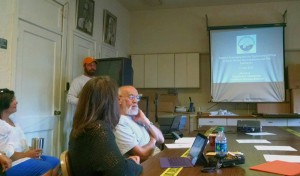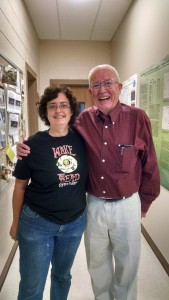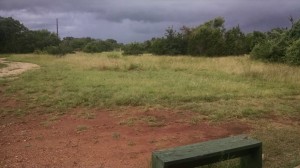I’ll be curating the @realscientists twitter account for one week, starting tonight. I’ll be co-convening a session with Steve Macko on stable isotopes in ecological research at the Long Term Ecological Research Conference. Be sure to follow!
Updates from gwynethnotpaltrow Toggle Comment Threads | Keyboard Shortcuts
-
gwynethnotpaltrow
-
gwynethnotpaltrow
Congratulations, Jake!
Congratulations to Jake Smith on his successful Master’s defense entitled “Raccoon Scavenging and the Taphonomic Effects on Early Human Decomposition and PMI Estimation.”
Jake did a careful study of how raccoons can scavenge human bodies, leading to important insights in the patterns of how and when they scavenge. Megyesi et al (2005) published a study in the Journal of Forensic Sciences to estimate PMI (postmortem interval, or time since depth), based on rating changes in a corpse’s color, insect activity and soft tissue changes. However, Megyesi’s study did not include the effect of scavenging by animals. By using donors to ARF with known dates of death, Jake has been able to show that scavenging can cause estimates of PMI to be off significantly – which could have important implications for forensic cases. In addition, because raccoons are common scavengers throughout much of the US, this is an important consideration a wide geographic region.
In Texas State, the scavengers are not raccoons, but vultures. They also do a lot of research on vultures, who play a critical role in many ecosystems. The patterns of scavenging for these two animals are quite different.
There are now six facilities in the US for studying the processes of human decomposition, and it’s clear that these are really all needed. Differences in scavengers, terrain and climate can cause dramatic differences in how people decompose, and it’s important to understand how those differences may be reflected in discovered remains.
Another thing I learned in Tennessee is how many forensic cases never make the news. For every case that makes the national news, there are many that never do. Some of these are skeletal remains for people that may have died of natural causes, or suicides. However, without highly trained forensic anthropologists, those manner of death determinations can be difficult. Although this type of research may be macabre or disturbing to many people, it is critical in solving cases and bringing criminals to justice.
-
gwynethnotpaltrow
Team effort
Doing this research involves a significant amount of physical labor as well as intellectual effort. I’m extremely grateful for all the help I’ve had both at UT and Texas State. Over the last week, we’ve placed five donors for this project, three in surface plots protected by cages to prevent scavenging and two in burials. This definitely wouldn’t be possible without the incredible assistance of undergrads (many volunteers!), interns, grad students and faculty keeping this complex facility running smoothly. From digging graves, placing donors, taking daily photographs and carefully documenting the processes of decomposition, there’s a lot of good will despite all the hard work and olfactory issues associated with decomposing bodies.

From left to right, Sydney Shaver, Jessica Newcomb, Victoria Bates, Christine Bailey (volunteer coordinator), Abigail Brennan and Tiffany Saul (grad student). Bonnie Simmons not pictured. We worked hard to get our placements done before severe thunderstorms swept back in.
Two other grad students, Angela Dautartas and Jake Smith, also put in far more hours than they are paid for. They do tasks ranging from picking up donors, completing donor intake, building cages to keep out scavengers (mostly raccoons) as well as doing their graduate research. Jake has 15 years experience in managing a funeral home, so he does much of the coordination with donors and their families. He works very hard to make sure the donation process is going to work emotionally for the donors’ families, while balancing the needs of researchers. Although he’s only wearing one hat in the image below, he wears many in real life.

University of Tennessee, Knoxville grad students Angela Dautartas and Jake Smith (wearing hat) take proper precautions when handling human remains.
Many of the donors have pre-willed their bodies to the facility, filling out extensive paperwork about where they were born, where they’ve lived and detailed medical histories. This information is critical not just for current research, but because later on the donors will become part of the largest modern skeletal collection in the world, with more than 1200 individuals. If you look at the literature of forensic anthropology, you’ll quickly realize that many of studies estimating age, sex and racial group come from this collection.
Angela and Jake showed me the steps behind the intake process. This is where donors are carefully photographed, with any injuries, trauma and the condition of teeth are carefully noted. The donors are weighed and measured, and samples of blood, hair and nails are taken for future analysis. Jake is familiar with the many research studies going on at one time, and will evaluate which studies any particular individual donor will be involved in. They are then taken up to the facility, where they will be photographed and observed daily throughout decomposition.
-
gwynethnotpaltrow
water, water everywhere!
During the time between my two sites, I worked on getting as much data as I can to make sure everything is working properly. With the assistance of Vince Debes, I measured the elemental composition of the water samples I collected at Texas State, and was able to compare them to the values I estimated from waterisotopes.org, a fantastic free resource from the University of Utah by Professor Gabriel Bowen (among others). If you’re interested in how they’re able to predict what isotope values should occur at any particular site, they have a great tutorial here.
The precipitation samples I measured – two rainwater samples and one throughfall sample – at sites at Texas State are the same within analytical error, and very similar to the values predicted by Isomap. Throughfall is rainwater that falls through vegetation like trees, and collects dirt, dust and material from the vegetation – and you can see the difference from rainfall in the picture below.

The middle sample was from a site in the middle of a set of trees and is throughfall. The rainfall samples on the right and left were located in open areas.
Stable isotopes are always measured relative to a standard, because we can measure small differences between things far more accurately than the absolute value of something. If you were looking at a group of people, it’s far easier to tell that Jeanette is about 1 inch taller than Maria, than to tell that Jeanette is five foot four inches tall. In the next post, I’ll discuss the results in more detail.
-
gwynethnotpaltrow
Dr. Bass!
I’m now in Tennessee at the original “Body Farm” continuing my research. Today, I was thrilled to have the opportunity to meet Dr. Bass, who started the facility (Anthropological Research Facility, or ARF) in 1981 to scientifically study the processes of human decomposition. In the beginning, doing this type of research offended a lot of people, but much of what we know about how to estimate time of death with insect activity, visual and chemical changes comes from him and his students. You can actually take a short video tour with Dr. Bass through the Body Farm here, but please note that there are images of human skeletal remains in the video.
Dr. Bass started an Anthropological Response Team that would go out to crime scenes with human remains in Tennessee – previously, law enforcement would just bring him a skull and perhaps a couple of bones. His idea that looking at the entire context of the scene by someone who was an anthropological expert made him a real visionary. He’s also a board-certified forensic anthropologist – one of only 106 in all of US history!
As with many scientists, and perhaps anthropologists in particular, he’s a wonderful storyteller. We chatted for some minutes and he told me of cases he’s worked and I could tell he’s still passionate about helping families to figure out what happened to their loved ones.
The term “Body Farm” was popularized by Patricia Cornwell’s novel, who has a main character based on Dr. Bass. With John Jefferson, Dr. Bass has written eight novels as well as an autobiography, so clearly he’s been honing his storytelling abilities for many years.
-
gwynethnotpaltrow
Coming…and going
I survived the weather in Texas, and have returned to ASU just long enough to unpack and restock supplies before going to the University of Tennessee, Knoxville. My samples made it back safely, but most measurements will have to wait until after my trip to Tennessee.
Tiffany Saul, a graduate student at UTK, will be coming here to ASU this fall to run some isotope analyses on the samples, as well as some of her thesis samples. She’s just finish going to IsoCamp through the University of Utah, so she’ll have a good opportunity to apply what she’s just learned about stable isotopes in ecology to our studies of the Body Farm in Tennessee. Utah has added a second course, SPATIAL, to cover the rapidly emerging topic of “isoscapes”, or isotopic landscapes.

Oxygen and hydrogen isoscapes in plants, from Jason West’s group at Texas A&M.
The concept that isotope ratios vary in systematic and predictable ways with geography is at the heart of the idea of figuring out where people were born or have moved. Our bodies are built when we eat food (carbon, nitrogen, strontium, even lead!), and drink water (oxygen and hydrogen). This leaves everyone with a measurable chemical and isotopic signature of where you live. This concept has been used for several decades in ecology and anthropology, to help understand animal migrations and ancient populations. It’s been championed in forensics and nutrition by a handful of researchers for more than a decade, but it has taken a while to become widespread. It employs concepts from geology (isotopic fractionation and measurements, large scale climate patterns), biology (metabolism), chemistry, and culture (food choices, migrations), so it requires researchers to cross boundaries between traditional scientific disciplines. It’s a very powerful tool that is finding wider application, and I’m excited to be a part of this emerging discipline.
-
gwynethnotpaltrow
Tropical Storm Bill
Well, I was concerned about not getting enough precipitation to fill up my samplers, but my fears have proven to be unfounded! We’ve been drenched quite a bit while I’m here, but I can’t celebrate too much because 12 people died, and 2 children are still missing in Memorial Day flooding. Tropical Storm Bill has moved into our area, and we’re under a flash flood watch, and schools are closing. Originally, I had been slated to return tomorrow, but I will extend my trip for a couple of extra days so I don’t get stuck at the airport.
Besides, everyone here has been so welcoming! One of the wonderful things about travelling is getting exposed to new techniques and ideas, and explaining your research to others. I had a great conversation this morning with Forensic Odontologist Dr. James Fancer, DDS, PhD, and got some great advice about tooth extraction techniques. I also got to see the newest results from their 3D printer.
-
gwynethnotpaltrow
Operation ID
Despite being Saturday, grad students were busy at the facility today, so I was able to spend much of the day cleaning more hair samples. I need to remove all the soil, vegetation and “other” materials so that I will be able to measure the elements and isotope composition of just the hair. It’s tedious work, but I’m actually quite happy, because I’m going to be able to analyze more samples than I initially thought. Later on, the hair will also undergo chemical cleaning. I’ll save part to examine under the microscope to see if the physical structure has changed, but most of it will be ground up in a ball mill cooled by liquid nitrogen. We need to keep the hair cold when grinding so that it will be brittle and can be ground very fine.
The students here at Texas State are particularly busy this weekend because next week students from the University of Indianapolis will be here. The Indianapolis students will learn how to write up the forensic reports for the border crossers in Operation ID. In 2011-2013, Brooks County, Texas had a surge of 296 migrants who died trying to cross the US-Mexico border. Overwhelmed, and with no funds to cover investigation or burial, the migrants were buried in a mass grave with very little attempt to identify them. As Dr. Spradley, PI of the project, points out, that’s equivalent to a Boeing 737 crashing. Mostly staffed by volunteers, Texas State and the University of Indianapolis have exhumed many of these migrants and are trying to identify them through a combination of physical traits inferred from forensic anthropology and personal effects.
Although there are larger mass graves in other parts of the world, I hadn’t thought there would be mass graves in the US in 2013! They suspect that many of the migrants are from Guatemala, while many of the migrants who cross the Arizona border are from Mexico. This signal of different geographic origins should show up very clearly in the stable isotope signatures, and I would love to be able to assist this group in the future so that the families of the missing have closure.
-
gwynethnotpaltrow
Texas State San Marcos Forensic Anthropology Research Facility (FARF, aka “Body Farm”)
I’ve had a busy several days here. Dr. Daniel Wescott, director of the facility, and Dr. Deborah Cunningham have been very welcoming and they have some really nice facilities.
The weather’s been threatening rain, so I set up my precipitation samplers with the assistance of Texas State grad student Brittany McClain. We also collected several soil cores in the sticky Texas clay. We’re collecting rainwater and soil to see what elements and isotopes might be exchanging with the different tissues I’m studying. I want to understand how well the isotopic signatures before death are preserved, so I need context about the soil and water.
The students here at Texas State collect samples of DNA, hair and fingernails from donors when they arrive. Yesterday, I collected a number of hair samples from bodies that have been outside for various periods of time, from a few days to six months. I’ll be able to compare hair when they first arrived to now, to see how the chemical signatures evolve.
If you’re interested in reading about a real-life example where this type of analysis provided crucial help to identify a victim, you can read more about it here. The case mentioned in that link was particularly interesting because isotopic changes along the length of the hair suggested frequent moves between regions. I’m hoping to provide some of the basic research to determine if these isotopic signatures are robust.
A quick note – there will be no graphic pictures on this blog. The donors and their families have done an incredible service to society by allowing us to study them, and everyone I’ve met involved with this type of research is concerned with protecting donors’ privacy and respecting them for their gift to research and science. People can pre-register for full-body donation at FARF.
-
gwynethnotpaltrow
Being in the field can be a whirlwind of activity, but what tends to get glossed over is all the preparation and work that goes into a project before it ever gets to the field. Fieldwork begins months before a researcher leaves the lab, even if you don’t count coming up with the idea, building collaborations with other researchers, and grant submission. I’m preparing for some really exciting research on the isotopic taphonomy of human remains, and I’m in the last phase of getting ready to go in the field.
Isotopes can be very powerful in helping to determine information about where someone was born, where they’ve travelled and what kind of diet they ate. In cases where a body is found with no identification, this can be very helpful in providing investigative leads to identify them – particularly if they don’t have any matching DNA in CODIS. This kind of research has been used for decades in anthropology to understand migration of ancient populations, but only recently have these tools started to be used in the context of modern forensics.
Isotopes have been used in selected case studies, but there hasn’t been systematic study to see how well these signatures are preserved after death as a body decomposes in the context of modern forensics. The Department of Justice has funded us to look at this issue. We’ll be analyzing hair, tooth enamel and bone of individuals who have donated their bodies to science at two “Body Farms” – the University of Tennessee, Knoxville and Texas State, San Marcos. These two sites have really different climates, so we should be able to look at the role of precipitation and humidity on decay. San Marcos is similar in climate to a lot of the border to Mexico, and so we hope to be able to use the results of this research to help families find closure if family members don’t make it through the desert while attempting to come across to the US.
In order to understand the context, we’re also collecting rainwater, groundwater and soil samples. This will let us look at the endmembers that may be contributing chemical signatures to the bodies and help us understand what the controlling factors are. We’ll be looking at oxygen, hydrogen, carbon, nitrogen, strontium and lead isotopes, as well as elemental composition. Collecting hair, bone, tooth enamel, groundwater, precipitation and soil cores for all these different types of analyses is challenging because each type of analysis has its own consideration in sample collection and storage, and each sample type has multiple protocols for collection.
-
Rich Weite
Thanks – great stuff!
-










Reply